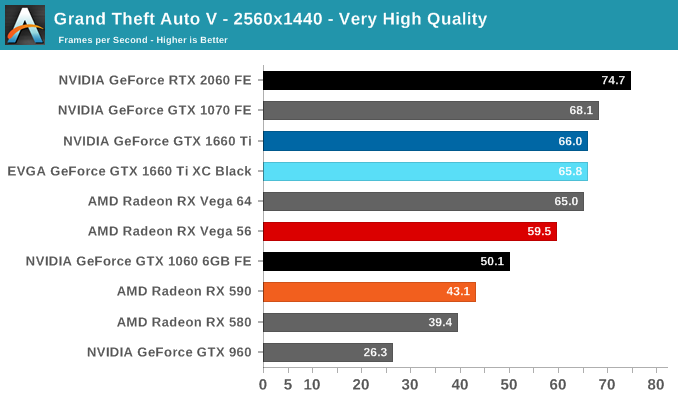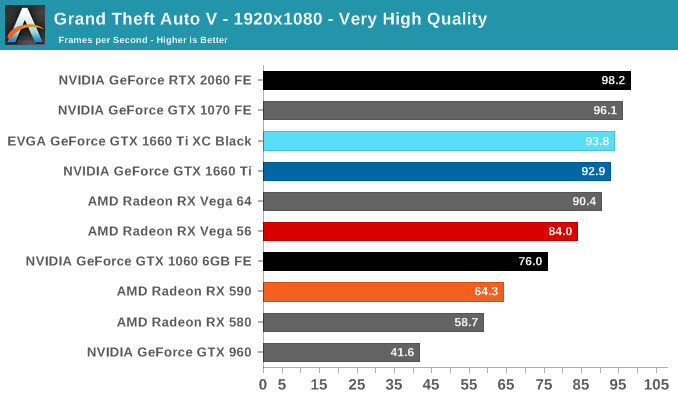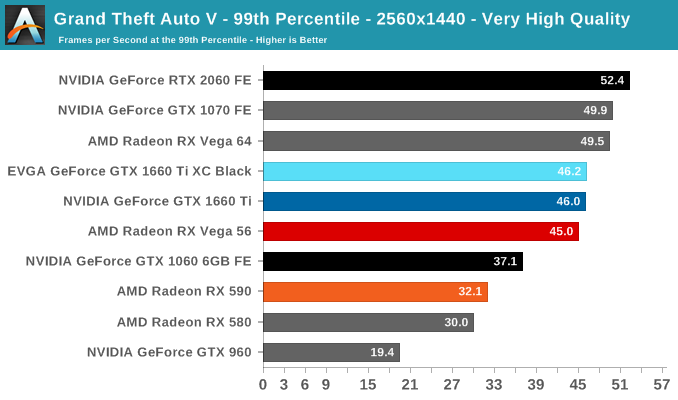The NVIDIA GeForce GTX 1660 Ti Review, Feat. EVGA XC GAMING: Turing Sheds RTX for the Mainstream Market
by Ryan Smith & Nate Oh on February 22, 2019 9:00 AM ESTGrand Theft Auto V (DX11)
Now a truly venerable title, GTA V is a veteran of past game suites that is still graphically demanding as they come. As an older DX11 title, it provides a glimpse into the graphically intensive games of yesteryear that don't incorporate the latest features. Originally released for consoles in 2013, the PC port came with a slew of graphical enhancements and options. Just as importantly, GTA V includes a rather intensive and informative built-in benchmark, somewhat uncommon in open-world games.
The settings are identical to its previous appearances, which are custom as GTA V does not have presets. To recap, a "Very High" quality is used, where all primary graphics settings turned up to their highest setting, except grass, which is at its own very high setting. Meanwhile 4x MSAA is enabled for direct views and reflections. This setting also involves turning on some of the advanced rendering features - the game's long shadows, high resolution shadows, and high definition flight streaming - but not increasing the view distance any further.
We've updated some of the benchmark automation and data processing steps, so results may vary at the 1080p mark compared to previous data.




For the GTX 1660 Ti, it's becoming clear that it is beyond firmly faster than the RX 590, its nominal competition at the $279 price point. The card pips the RX Vega 64, putting it in the realm of 1.4X to 1.5X faster than the RX 590, and around 10% faster than the RX Vega 56.
There's no mincing words here; while NVIDIA hardware may run better on GTA V in general, the size of GTX 1660 Ti's lead over the RX 590 is just crushing for the same MSRP, and equally so against the generally pricier RX Vega 56.











157 Comments
View All Comments
Midwayman - Friday, February 22, 2019 - link
I feel like they don't realize that until they improve the performance per $$$ there is very little reason to upgrade. I'm happy sitting on an older card until that changes. Though If I were on a lower end card I might be kicking myself for not just buying a better card years ago.eva02langley - Friday, February 22, 2019 - link
Since the bracket price moved up so much for relative performance at higher price point from the last generation, there is absolutely no reason for upgrading. That is different if you need a GPU.zmatt - Friday, February 22, 2019 - link
Agreed. It's kind of wild that I have to pay $350 to get on average 10fps better than my 980ti. If I want a real solid performance improvement I have to essentially pay the same today as when the 980ti was brand new. The 2070 is anywhere between $500-$600 right now depending on model and features. IIRC the 980ti was around $650. And according to Anantech's own benchmarks it gives on average 20fps better performance. That 2 generations, 5 years and I get 20fps for $50 less? No. I should have a 100% performance advantage for the same price by this point. Nvidia is milking us. I'm eyeballing it a bit here but the 2080Ti is a little bit over double the performance of a 980Ti. It should cost less than $700 to be a good deal.Samus - Friday, February 22, 2019 - link
I agree in that this card is a tough sell over a RTX2060. Most consumers are going to spend the extra $60-$70 for what is a faster, more well-rounded and future-proof card. If this were $100 cheaper it'd make some sense, but it isn't.PeachNCream - Friday, February 22, 2019 - link
I'm not so sure about the value prospects of the 2070. The banner feature, real-time ray tracing, is quite slow even on the most powerful Turing cards and doesn't offer much of a graphical improvement for the variety of costs involved (power and price mainly). That positions the 1660 as a potentially good selling graphics card AND endangers the adoption of said ray tracing such that it becomes a less appealing feature for game developers to implement. Why spend the cash on supporting a feature that reduces performance and isn't supported on the widest possible variety of potential game buyers' computers and why support it now when NVIDIA seems to have flinched and released the 1660 in a show of a lack of commitment? Already game studios have ditched SLI now that DX12 pushed support off GPU companies and into price-sensitive game publisher studios. We aren't even seeing the hyped up feature of SLI between a dGPU and iGPU that would have been an easy win on the average gaming laptop due in large part to cost sensitivity and risk aversion at the game studios (along with a healthy dose of "console first, PC second" prioritization FFS).GreenReaper - Friday, February 22, 2019 - link
What I think you're missing is that the DirectX rendering API set by Microsoft will be implemented by all parties sooner or later. It really *does* met a need which has been approximated in any number of ways previously. Next generation consoles are likely to have it as a feature, and if so all the AAA games for which it is relevant are likely to use it.Having said that, the benefit for this generation is . . . dubious. The first generation always sells at a premium, and having an exclusive even moreso; so unless you need the expanded RAM or other features that the higher-spec cards also provide, it's hard to justify paying it.
alfatekpt - Monday, February 25, 2019 - link
I'm not sure about that. It is also an increase in thermals and power consumption that also costs money overtime. RTX advantage is basically null at that point unless you want to play at low FPS so 2060 advantage is 'merely' raw performance.For most people and current games 1160 already offers ultra great performance so not sure if people gonna shell out even more money for the 2060 since 1160 is already a tad expensive.
1160 seems to be an awesome combination of performance and efficiency. Would it be better $50 lower? of course but why? since they don't have real competition from AMD...
Strunf - Friday, February 22, 2019 - link
Why would nvidia give up of a market that costs them almost nothing ? if 5 years from now they do cloud gaming then they pretty much are still doing GPU.Anyways even in 5 years cloud gaming will still be a minor part of the GPU market.
MadManMark - Friday, February 22, 2019 - link
"They are pushing prices up and up but that's not a long term strategy."That comment completely ignores the massive increase in value over both the RX 590 and Vega 56. Nividia produces a card that both makes the RX590 at the same pricepoint completely unjustifiable, and prompts AMD to cut the price of the Vega 56 in HALF overnight, and you are saying that it is *Nvidia* not *AMD* that is charging high prices?!?! I've always thought the AMD GPU fanatics who think AMD delivers more value were somewhat delusional, but this comment really takes the cake.
eddman - Saturday, February 23, 2019 - link
It's not about AMD. The launch prices have clearly been increased compared to previous gen nvidia cards.Even this card is $30 more than the general $200-250 range.